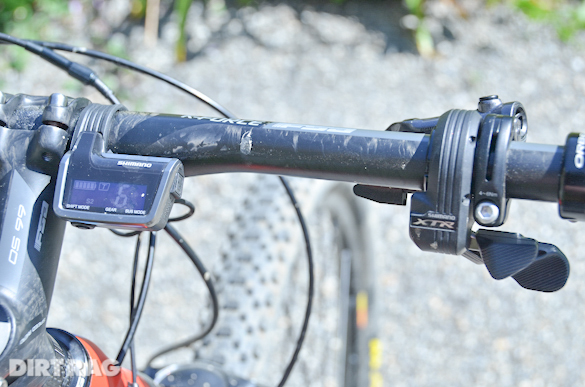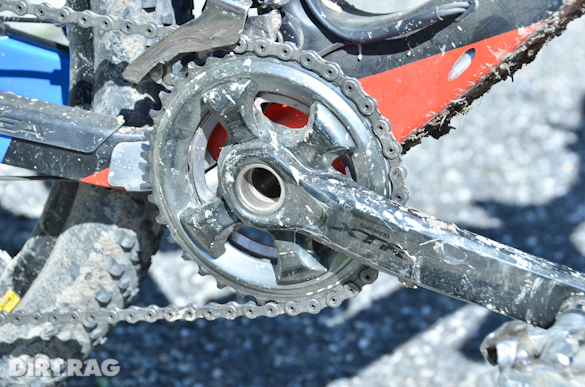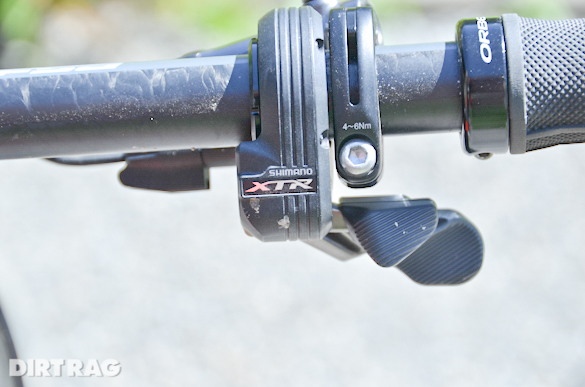Inside Line: First ride on the 11-speed Shimano XTR and XTR Di2
Originally posted on August 27, 2014 at 14:00 pm
Coming as a surprise, the entire fleet of media demo bikes for the recent Orbea Oiz launch was outfitted with 11-speed 2015 XTR, including four sets of the scarce electronic shifting M9050. We managed to put in a good ride on both groups.
Shimano originally announced the new XTR back in April, and we got a spin around a parking lot on prototype parts, and fondle clay mock-ups of what the production groups would look like. Things went quiet for months after that, with no set date on when the new parts would be ready for sale.
These parts are mostly still marked as prototypes, but we shouldn’t expect much to change between now and when they will show up on 2015 bikes and your local bike shop’s shelves. Don’t ask about prices, we still don’t have them. I’m not going to go over all the tech of the new group, if you need a refresher, blogs of on the M9000 are here, and M9050 is here. I’ll wait for you catch up.
Ready? Head full of numbers and words like FREEZA? Let’s clear the air with some real ride impressions, starting with M9000.
M9000
I rode the Race version of this group, the Trail version only differs in crankset (hollow forged vs. bonded) and brakes. The brakes don’t differ very much from the current 10 speed XTR versions and the bonded cranks I rode seemed plenty stiff. The forged Trail cranks are going to be stronger, heavier and wider, with a 168mm q-factor versus the Race 158mm.

All bikes had 36-26 chainrings and the new 11-40 11-speed cassette. Front shifting with the new Side-Swing front derailleur is nothing short of stellar. With less shifting effort and what felt like a stiffer derailleur, along with some of Shimano’s magic ramps and pins, there is no doubt this is the shifting against which all else will be measured. Rear shifting was excellent as well, but not the obvious jump in performance as the front.

Both sets of Race brakes I rode seemed like they might have needed another bleed, as the engagement point was sometimes inconstant, something I never had an issue with the previous M987s I recently reviewed. Since the Mavic wheels on the Orbea Oiz are 6-bolt only, the excellent center-lock only Freeza rotors could not be used, and on the long descents around Meribal, France some brake pump was noticed, but much the same as the 987s, it never seemed to affect power. It is possible to swap in the Ice-Tech finned pads from the Trail brake, something I would recommend if the Freeza rotors are not an option.

M9050 Di2
Now that 29ers, 27.5ers, fat bikes and enduro have all taken theirs turns as the whipping boy for malcontent internet commentators, Shimano timed the release of its new electronic shifting to perfectly drop in as the new target for the ire of the online haters.

I’ll be upfront, I agree there is little “need” for electronic shifting, but going down the “need” road gets you nowhere. None of us “need” mountain bikes. XTR Di2 is the result of Shimano combining its years of experience engineering the highest level of road and off-road components to create the most technologically advanced mountain bike drivetrain we’ve ever seen. If that doesn’t sound like something you are interested in you won’t accomplish anything by reading further.
Orbea designed the Oiz to run the seatpost mounted battery, so that remains tucked away inside the frame, out of sight and out of mind. Charging is done via the head unit, using a USB power supply/interface cord. While the stock shifting settings are easy to learn, there is a sweet app (for PC or Mac) that allows you to fiddle with all manner of things, including: assigning different buttons to shift, adjusting how the Syncro shift works (including running a single shifter for a 2x system), and changing how quickly the derailleur shifts when the button is held down. We got a quick demo of the app, it seemed easy to use and experiment with. No smart phone option yet, a bit of a bummer as messing with settings in the field seems the best way to dial in preferences.

The shifters took some getting used to, as the buttons are not in the familiar thumb and trigger positions I’m used to from Shimano and SRAM mechanical shifters. The large, lower button seemed like it should be the same as the thumb paddle on a trigger shifter, but my muscle memory kept trying to use it as the trigger, often leading to a easer gear when I wanted a harder. The upper button wasn’t in a familiar place at all, making it hard to find when hunting for a harder gear in technical terrain. More ride time will get rid of this feeling, or reprogramming the buttons to something more intuitive to me, but I can see riders with multiple bikes might be frustrated by the different shift level positions.
The feel of the levers are excellent, with short throw and detents just big enough to be effective. I was hoping a half push on the buttons would activate the display from sleep mode, but the button on the display was the only way to activate the screen besides shifting. It is very easy to set the screen sleep time from two seconds to 300 seconds, so this is not really much of a bother.

Fox’s electronic suspension control is compatible with the Di2 system, so a single battery and control unit can keep everything neat and tidy. Unfortunately, we didn’t get to experience this, as the suspension used Fox’s cable remote. Maybe by Interbike we’ll see the whole system in action?
I decided to get the full electronic experience and run the bike in Syncro mode the whole ride. I used preset map number one, which shifted from the big ring up to the 40 tooth cog, then dual shifted to the small chainring and down two cogs. Going the other way, it went down four cogs before getting back in the big ring and down a cog.
This might sound pretty complicated, but in use it was all pretty seamless, although a dual shift was noisy and had a moment of spinning in neutral at the pedals, but it was less than am eighth of rotation, and sounded worse than it felt. The rest of the shifting was as close to perfect as you are going to get.
An electronic buzz is followed by a quiet click and the new gear is selected, and you pedal way. Front shifting is the only thing better than the M9000 mechanical shifting, since the electronic group can “overshift” for a bit to get a crisp gear change, then move the derailleur back to prevent chain rub. This used to be called “trimming” the derailleur and it was possible (and necessary) with non-indexed shifting, but who wants to hear about that? The only time I had trouble shifting was intentionally starting out in a huge gear on a hill, I needed to shift to easy cogs in the back before the chain would move to the small ring on the crank.

Assuming the excellent weatherproofness proven by multiple cyclocross seasons carries over from the road groups, I would expect XTR Di2 to be more reliable in bad weather than the mechanical group, as seemingly counterintuitive that sounds.
Gearing Range
As expected, the new XTR lives up to the performance we expect. The real question that we’ll see answered in the coming year is how it stacks up against SRAM 1×11 groups. XTR does have a range of single rings available, in 30, 32, 34, and 36, but will the 11-40 cassette be enough range to keep 1x riders of different disciplines and fitness levels happy? Rumor has it that the few Pro men racing the new XTR groups are all running 1x to race, with 2x for training.

On a train ride to Eurobike from the Orbea launch in France, I crunched the numbers comparing the Shimano group to a SRAM 1×11 with a 32 tooth ring.
As it turns out, Shimano’s 36×11 high gear (91.2 gear inches) is slightly higher than the 32×10 (89.2 inches) of SRAM, and the 26×40 low gear (18.1 inches) is just lower than the 32×42 (21.2 inches). Between those high and low range, the ratios in the Shimano group are closer together for smaller jumps between gears, something it has long championed. Is a second chainring, shifter and front derailleur worth it to most riders for what comes down to two easier gears?
I know more than one rider who prefers the bigger jumps between gears on SRAM 1×11 systems than the tighter jumps on a 10 speed cassette. Since Shimano effectively added a 40 tooth cog to the 11-36 range, those complaints will remain. And the available doubles are all 10 teeth apart in gearing range, which keeps ratios close, but overall range is smaller, something that is a bit of a shame on a bike with 22 gears. But for riders that are sensitive to cadence changes, the new XTR is going to be a perfect match.
Is XTR Shimano’s “answer” to the 1×11 SRAM juggernaut? In my opinion, it is not. What XTR is, as it has always been, is Shimano’s premier off road group, designed for how Shimano thinks riders should or would like to ride their bikes, a refinement of a already incredible set of components, rather than the rethinking of drivetrain design.